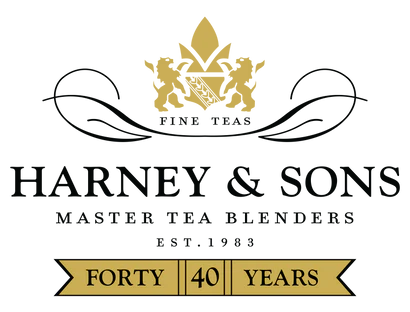Frequently Asked Questions
Q: Is Harney & Sons English Tea?
A: Well, if the question is, whether or not our tea is grown in England, the answer is no. Until recently there was no tea grown in England, due to the climate. Now, there is one small garden in Cornwall. However, we do have an English Breakfast Tea, which is 100% Keemun (which was the original English Breakfast blend). Also our teas are used in one of London’s finest hotels: The Dorchester. See our Dorchester Blend.
Q: What is the best way to store loose leaf tea?
A: It is fresh air, oxygen to be specific, that robs the flavour from loose leaf teas. Store the teas in an air tight container away from moisture and direct sunlight. Don't store teas in the refrigerator or freezer. The cooler temperatures are not helpful: there is moisture, and the delicate leaves will pick up strong odors.
Q: What is a tea sachet?
A: Our tea sachets are pyramid-shaped silky nylon teabags that are filled with whole-leaf loose tea. The benefit of the pyramid shape is that it allows the tea leaves to expand fully, thus allowing the full tea taste to develop. The nylon is food safe and stable in boiling water. Each tea sachet contains just enough tea to brew 2 cups of tea.
Q: What is the difference between Green and Black teas?
A: All teas originate from the same species, the Camelia Sinensis. To make green tea, the fresh tea is briefly cooked using either steam or dry heat. This process "fixes" the green colours and fresh flavours. For black tea, the tea is left outside and becomes limp (withered), then put into machines that roll the leaves and damage them. The damaged leaves change colour to brown, then black. This natural process is called oxidation. After that all tea is dried, so that it can be shipped great distances. The oxidation process changes the flavour of the tea (now black) and gives it more body.
Q: How much caffeine is in green tea?
A: It is quite difficult to gauge how much caffeine is in a tea, because it depends on so many factors: the tea itself, how much is used in a cup and how long it is brewed. But the general rule is that a cup of green tea contains about 1/3 as much caffeine as a cup of coffee.
Q: How do you decaffeinate your teas?
A: All of our decaffeinated teas have the caffeine removed using the CO2 process developed in Germany as a natural alternative the the methylene chloride process that has become the industry standard. The tea is circulated with the cardon dioxide and caffeine-free tea is the result. No unpleasant tastes or traces of the solvent remain in the tea.
The smaller leaves are a normal result of this special decaffeination process.
The CO2 used in the extraction process is completely harmless.
Q: What is White Tea?
A: White tea is made from the young tea leaf. It is picked just before the leaf opens on the stem, air-dried to lock in its colour and flavour. The lack of chlorophyll in the immature leaf gives it its 'white' appearance. Aromatic and delicate bodied, use more of the large leaf to get its full flavour. It has both caffeine and healthy polyphenols.
Q: What is an Oolong?
A: Oolong tea is sometimes referred to as Brown tea, because it is considered by some to be halfway between a black tea and a green tea. In many respects it is the most complicated tea to make, because the tea is only partially oxidised. That is like keeping a banana perfectly ripe (nature keeps it moving towards being overripe.)
Q: What is the difference between herbal tea and decaffeinated tea?
A: Decaffeinated tea is tea from which the the caffeine has been removed, through one of two possible decaffeination processes. Herbal tea, on the other hand, is not really tea at all, but is herbs brewed in the same way that tea is brewed. Herbals are sometimes referred to as tisanes and never had any caffeine to begin with.
Q: Should tea be kept in the freezer?
A: No, tea should not be kept in the freezer. There are strong aromas and moisture in your freezer. Tea should be stored in a closed container, out of the light. Remember that tea is a blotter and will absorb strong smells!
Q: How do I brew the perfect cup of tea?
A: Start off with fresh boiling water. Pour boiling water over the tea sachet and allow to steep until ready. Follow the following guidelines:
| Tea Variety | Water Temperature | Steep Times |
| White Teas | 82˚C | 3 – 8 Minutes |
| Green Teas | 82˚C | 1 – 3 Minutes |
| Oolong Teas | 82˚C – 100˚C | 1 – 5 Minutes |
| Black Teas | 100˚C | 5 Minutes |
| Herbal Infusions | 100˚C | 5 Minutes |
Q: What do you look for in a teapot?
A: I search for two things in a fine tea pot: how it looks and how it pours. Much of the enjoyment of the world of tea is in the visual beauty of things. The tea pot plays an important part; it should be pleasing to the eye. A fine pot should also pour well and hold comfortably in the hand. It should pour smoothly with the lid resting securely in place. The tip of the spout should be level with or above the top of the pot and there should be a small breathing hole in the lid or upper rim of the pot to allow the tea to flow smoothly. And, of course, the spout should not drip.
If you have any other questions or comments please feel free to contact us.

